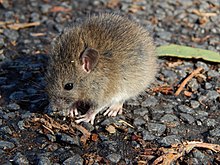Polynesian rat
| Polynesian rat Temporal range: Holocene
| |
|---|---|

| |
| Scientific classification | |
| Domain: | Eukaryota |
| Kingdom: | Animalia |
| Phylum: | Chordata |
| Class: | Mammalia |
| Order: | Rodentia |
| Family: | Muridae |
| Genus: | Rattus |
| Species: | R. exulans
|
| Binomial name | |
| Rattus exulans (Peale, 1848)
| |

| |
| Polynesian rat native range in Southeast Asia (in red) (note: the ) | |
The Polynesian rat, Pacific rat or little rat (Rattus exulans), known to the Māori as kiore, is the third most widespread species of rat in the world behind the brown rat and black rat. Contrary to its vernacular name, the Polynesian rat originated in Southeast Asia, and like its relatives has become widespread, migrating to most of Polynesia, including New Zealand, Easter Island, and Hawaii. It shares high adaptability with other rat species extending to many environments, from grasslands to forests. It is also closely associated with humans, who provide easy access to food. It has become a major pest in most areas of its distribution.
Description

The Polynesian rat is similar in appearance to other rats, such as the black rat and the brown rat. It has large, round ears, a pointed snout, black/brown hair with a lighter belly, and comparatively small feet. It has a thin, long body, reaching up to 6 in (15 cm) in length from the nose to the base of the tail, making it slightly smaller than other human-associated rats. Where it exists on smaller islands, it tends to be smaller still – 4.5 in (11 cm). It is commonly distinguished by a dark upper edge of the hind foot near the ankle; the rest of its foot is pale.[2]
Distribution and habitat
The Polynesian rat is widespread throughout the Pacific and Southeast Asia. Mitochondrial DNA analysis suggests that the species originated on the island of Flores.[3] The IUCN Red List considers it native to Bangladesh, all of mainland Southeast Asia, and Indonesia, but introduced to all of its Pacific range (including the island of New Guinea), the Philippines, Brunei, and Singapore, and of uncertain origin in Taiwan.[4] It cannot swim over long distances, so is considered to be a significant marker of the human migrations across the Pacific, as the Polynesians accidentally or deliberately introduced it to the islands they settled. The species has been implicated in many of the extinctions that occurred in the Pacific amongst the native birds and insects; these species had evolved in the absence of mammals and were unable to cope with the predation pressures posed by the rat. This rat also may have played a role in the complete deforestation of Easter Island by eating the nuts of the local palm tree Paschalococos, thus preventing regrowth of the forest.[5][6]
Although remains of the Polynesian rat in New Zealand were dated to over 2,000 years old during the 1990s,[7] which was much earlier than the accepted dates for Polynesian migrations to New Zealand, this finding has been challenged by later research showing the rat was introduced to both the country's main islands circa 1280.[8]
Behaviour
Polynesian rats are
Diet
R. exulans is an
Rat control and bird conservation
New Zealand
In New Zealand and its offshore islands, many bird species evolved in the absence of terrestrial mammalian predators, so developed no behavioral defenses to rats. The introduction by the Māori of the Polynesian rat into New Zealand resulted in the eradication of several species of terrestrial and small seabirds.
Subsequent elimination of rats from islands has resulted in substantial increases in populations of certain seabirds and endemic terrestrial birds, as well as species of insects such as the
However, two islands in the Hen and Chickens group, Mauitaha and Araara, have now been set aside as sanctuaries for the Polynesian rat.[10]
Rest of the Pacific
Between July and November 2011, a partnership of the Pitcairn Islands Government and the Royal Society for the Protection of Birds implemented a poison baiting programme on Henderson Island aimed at eradicating the Polynesian rat.[12] Mortality was massive, but of the 50,000 to 100,000 population, 60 to 80 individuals survived and the population has now fully recovered.[13]
References
- ^ Ruedas, L.; Heaney, L. & Molur, S. (2008). "Rattus exulans". IUCN Red List of Threatened Species. 2008. Retrieved 6 February 2010.
- ^ "Kleine Pazifikratte (German), kiore (Maori), Maori rat (English), Pacific rat (English), Polynesian rat (English), tikus Polynesia (English, Indonesia)". Global invasive species database. Retrieved 7 October 2023.
- PMID 24637896.
- ^ Ruedas, L. (2016-08-17). "IUCN Red List of Threatened Species: Rattus exulans". IUCN Red List of Threatened Species. Retrieved 2021-01-08.
- ^ Flenley, John R. (2003) The enigmas of Easter Island
- ISBN 978-0-670-03337-9.
- S2CID 22648001.
- PMID 18523023.
- ^ Auckland Conservancy. 2006. Kiore / Pacific Rat/ Polynesian Rat Archived 2010-05-18 at the Wayback Machine New Zealand Department of Conservation
- ^ Tahana, Yvonne (3 June 2010). "Rare rats off the hook as DoC gives them island sanctuary". The New Zealand Herald. Retrieved 3 November 2011.
- ^ Jamieson, Regen (18 April 2014). "Removing Rats and Rabbits: An Interview with Ray Pierce". New England Aquarium - Phoenix Islands Blog. Retrieved 25 January 2015.
- ^ Royal Society for the Protection of Birds. "Henderson Island Restoration Project". Retrieved 28 May 2012.
- PMID 27152226.
- "ISSG entry: Rattus exulans". Archived from the original on 2020-06-01. Retrieved 2006-12-05.
External links
- D. J. Campbell; I. A. E. Atkinson (1999). "Effects of kiore (Rattus exulans Peale) on recruitment of indigenous coastal trees on northern offshore islands of New Zealand" (PDF). Journal of The Royal Society of New Zealand. Vol. 29 No 4, December 1999, pp. 265–290. Archived from the original (PDF) on 2008-04-11. Retrieved 2007-06-17.
- Auckland Conservancy (2006). "Kiore / Pacific Rat / Polynesian Rat" (PDF). New Zealand Department of Conservation. Archived from the original (PDF) on 2010-05-18. Retrieved 2010-03-05.

